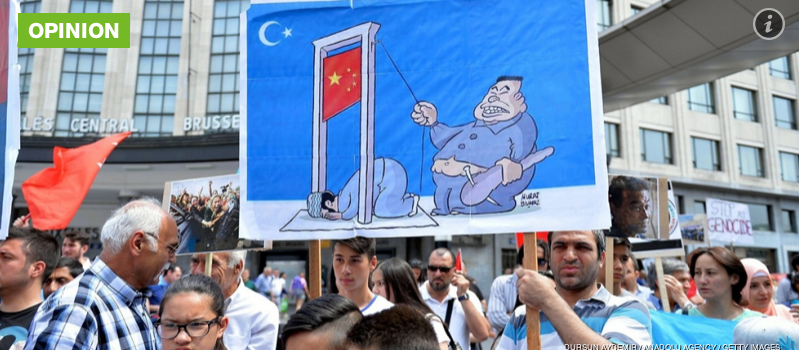Last month Chinese authorities in the predominantly Uighur province of Xinjiang reportedly ordered civil servants, students and teachers not to fast and restaurants to remain open during the Muslim holy month of Ramadan. Similar allegations were made last year.
Unsurprisingly, the report was met with widespread outcry outside China. The global protests even forced the Chinese Foreign Ministry to address the allegations in press conference with reporters on July 6.
“Uighur is one of the 56 ethnic minorities in China. More than 10 million Uighur Turks are living happily and peacefully,” ministry spokeswoman Hua Chunying told reporters in Beijing, denying the ban. “These people have the freedom of religion under the Chinese Constitution.”
There is little independent reporting from Xinjiang, but China routinely denies allegations of religious persecution against its Uighur population. The ruling Communist Party is officially atheist, and therefore some implicit bias is to be expected. But it is erroneous to conclude that the Uighur crisis is solely religious. The Uighur nationalists’ desire for more autonomy has long been at odds with China’s centralization policy. If anything, Chinese authorities are using the “war on terrorism” as a cover to demolish the Uighur people’s nationalist aspirations.
A struggle for autonomy
The Uighur struggle for self-rule arguably dates back to the 18th century, when the Qing dynasty conqueredthe Xinjiang province and incorporated it into China. Uighur nationalists organized several uprisings against the dynasty, which ruled China until the early 20th century. In 1949, Mao Zedong’s forces thwarted Uighur aspirations by imposing total control over Xinjiang, setting off the protracted tensions that have characterized the Uighur-state relations to date.
The Chinese government often blames violent episodes in the troubled province on Uighur separatists, attributing at least 200 violent incidents, including bombings and assassinations, to them from 1990 to 2001. But the violence and Uighur demonstrations have decreased since the late 1990s. Tensions escalated again in 2008, when a military police unit in Kashgar in western China was attacked during the Beijing Summer Olympics. The government blamed the Uighurs for the attack.
Members of the Uighur diaspora contend that the Chinese government is committing genocide against their people. For example, the U.S.-based Uighur Human Rights Project, which advocates for human rights in East Turkestan, says close to 700 Uighurs were killed from 2013 to 2014. “Although these numbers should not be considered definitive … they are indicative of deterioration in security conditions since Xi Jinping became Chinese president,” the organization said earlier this year.
In addition to the routine scapegoating for violence, the Uighur people have had their civil rights seriously compromised. Last year Georgetown University professor James Millward wrote that most state institutions in Xinjiang allegedly require Han ethnicity as a condition for employment. He added that the state interferes in the Uighur community’s cultural practices — for example through teaching only Mandarin in schools and restrictions on weddings, funerals and pilgrimage, or hajj.
Out of China’s 20 million Muslims, Uighurs account for approximately 6 million. Muslims in China are spread across the country, with most of them living outside Xinjiang and majority of them being Hui, who are closely related to the Han, who make up the majority of the Chinese people. But the state has been far more tolerant of the Hui than of the Uighur population.
“It seems clear that Hui Muslims have been granted so much more latitude because almost none have challenged secular authorities,” writes Gardner Bovingdon in his 2010 book, “The Uyghurs.” In fact, according to him, in Ningxia province a Sufi sect of Islam was even allowed to establish a “virtual religious state,” with several mosques and hundreds of thousands of followers. So much latitude, he says, that the leader or the movement openly proclaims listening to Osama bin Laden and meeting several “fundamentalist clerics” in Pakistan.
In his book “The Thistle and the Drone,” American University professor Akbar Ahmed recounts a conversations he had with a Hui Muslim named Emma, who spoke positively of the Chinese state, telling him, “Chinese Muslim minorities have the same rights and obligations as the other Chinese … They can be Chinese and be Muslims as well.”
According to Ahmed, Emma said that she visited mosques and met with imams in northwestern China and that most local Muslim leaders and mosque committee members spoke highly of their relationship with the state. He concludes that “too many of them [Uighurs] are seen as urchins and thieves” and “relatively backward in economic and educational condition, which will be a problem in the long run.” Emma told Ahmed that she believed “[the Uighur people] were different from the Hui,” citing their desire for independence.
National struggle
The media’s tendency to portray the Uighur issue as a solely religious conflict is at best misleading. Millward notes that Western journalists have used Islam as a “perennial hook” since 9/11 to make the conflict in Xinjiang a newsworthy event. “Indeed, at many Western media outlets it is arguably only the idea of a nexus of Islam, terrorism and China that justifies running a story about Xinjiang at all,” he wrote in 2004.
This portrayal betrays the Uighur people’s century-old resistance for greater autonomy and independence. The simplistic characterization of the Uighur struggle complicates their relations with China’s mainstream Muslim population. Given their vastly different experiences with the Communist Party, the one-dimensional portrayals perpetuate Uighurphobia, including among some Chinese Muslims.
The Chinese government must re-evaluate its policies in Xinjiang, which routinely invite negative coverage and international condemnation. But it is equally important that the media report on the troubled province more carefully. The Muslim character of the conflict is but one aspect of the Uighur people’s long struggle for freedom and autonomy.
Source: aljazeera.com

Leave a Reply